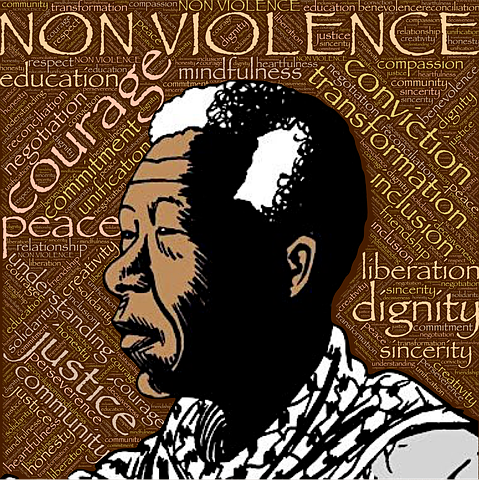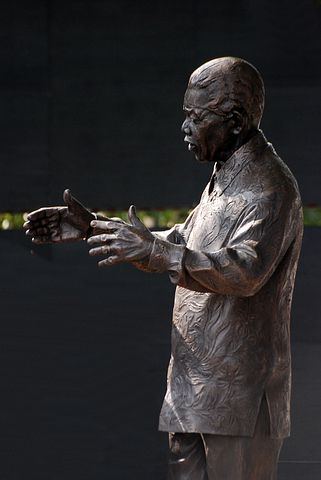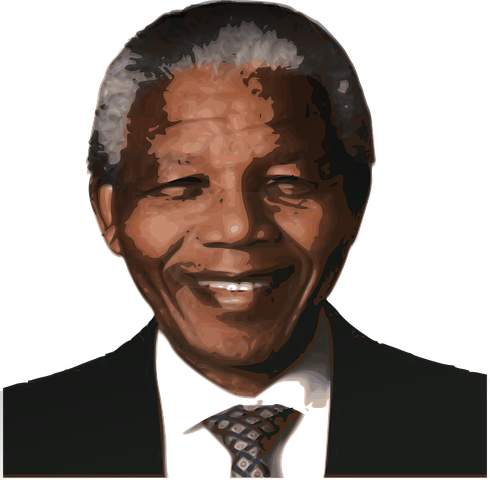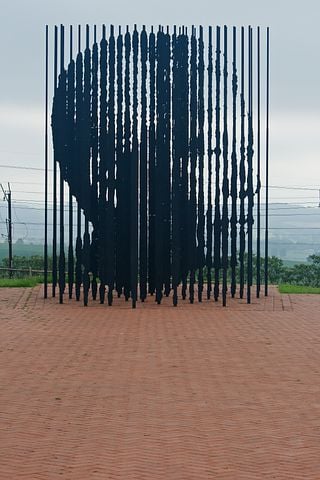
Nelson Mandela: Long Walk to Freedom Class 10: An autobiography issued on Nelson Rolihlahla Mandela, is the only prose in Chapter 2 of the First Flight English textbook for Class 10 students. He served as the nation’s first black president from 1994 to 1999 and was a revolutionary against Apartheid, and a political figure. Since it is an autobiography, the author of Long Walk to Freedom is Nelson Mandela himself. You may get a synopsis of the prose in the style of CBSE Notes right here. In addition, students can read the prose description of a passage from the book “A Long Walk to Freedom.” It features a drawing of Nelson Mandela’s inauguration ceremony and quotes from his speech on his battles as a freedom fighter.

Nelson Mandela: Long Walk to Freedom Class 10 Summary
The struggle of South Africa’s black population for liberation is described in Nelson Mandela’s narrative. On May 10, 1994, he took the oath of office as the president of South Africa, overturning more than three centuries of white rule. His party had received 252 votes throughout South Africa’s history.

The event, held at Pretoria’s theater, was attended by many politicians from other nations. He spoke to them with the utmost respect and promised them that racism and prejudice would have no place in the new South Africa. Together, they will all lead to growth. He promised to construct a democratic government and to treat everyone equally and with respect.
The day served as his metaphor as the populace chanted “Die stem” and “Nkosi Sikelel-i-Afrika,” two national anthems. He was reminded of his suffering due to this tyranny and repression by the events that were taking place. He believed that it was unacceptable for anybody to accept hate of others based on their ethnicity, religion, or other traits.
Great liberation warriors like Oliver Tambo, Walter Sisulu, Chief Luthuli, and others were consequences of the apartheid policy. The nation had a wealth of resources, but its most significant resource was its people.
It was through risk-taking, suffering torment, and learning that courage was not the absence of fear but the triumph over it. When pressed against the prison walls, a man’s inherent goodness allows him to detect compassion and love, and he can also detect the excellent nature of the guards.
He believed that if someone could be taught to hate, they could undoubtedly be taught to love. He listed every man’s two primary obligations: to his family and his nation and community. After he said that Apartheid prevented black people from carrying out their tasks, When Mandela reached her tender age, he understood that the black people would have become enslaved under the white people’s dominion if they had not raised their voices against tyranny.

Black people were subject to the tyranny of white supremacy. He said the oppressor is also imprisoned and robs the victim of their freedom. Their humanity is denied to them both.
Nelson Mandela: Long Walk to Freedom Class 10 Notes
Nelson Mandela: Long Walk to Freedom Class 10 Introduction
Former South African President Nelson Mandela’s autobiography is titled Long Walk to Freedom. An overview of Nelson Mandela’s long journey to liberation is contained in this article. The text in this chapter is taken from the book “Long Walk to Freedom.” It includes details about the swearing-in event, quotes from his speech, and information about his development as a freedom warrior. In addition, it speaks to the numerous other individuals who battled for their freedom. At that time, the oppressive practice known as “apartheid” was common in South Africa. It referred to prejudice towards people based on their ethnicity and skin tone. Dark-skinned individuals were denied their fundamental rights in one of the cruelest societies. This lesson summarizes Mandela’s initiatives to establish a society devoid of discrimination based on racial, ethnic, or gender preferences.
Nelson Mandela: Long Walk to Freedom Class 10 Explanation (Story )
To help you provide a brief review of Nelson Mandela: Long Walk to Freedom Class 10, below is an explanation :
Nelson Mandela remarks that it is an excellent day for the nation as they receive their first non-white democratically elected president at the beginning of the chapter Nelson Mandela: Long Walk to Freedom. Then, before taking the oath of office as president in front of international dignitaries, citizens of his beloved nation, army authorities, and his daughter Zenani, he announces the names of the individuals who would serve as vice presidents.

This lovely ceremonial inauguration was the first significant meeting of world leaders in South Africa. In his first address as president of South Africa, he welcomes this momentous occasion as the triumph of justice, peace, and human dignity, attained after a protracted battle against Apartheid. He promises to free the people of his nation from prejudice, poverty, and other hardships as he makes his closing remarks.
He also highlights all the beautiful events that occur during the celebration, such as the spectacular acrobatics that helicopters, troop carriers, and aircraft do while flying in the African flag colors. A few years ago, the same police officers would have arrested him instead of saluting him, so he is conscious of how far they have come when the defense forces and police salute and swear loyalty to him. The two national songs, which represented the harmony and peace he wished to see in his nation, played with white people singing the African anthem and black people singing the anthem that the state had previously used.
When he lists the names of the modern-day fighters who worked and gave their lives for their nation’s independence, Mandela appears a bit overawed. He regrets that he cannot personally thank the “total of all the African patriots.” They came before him since he believes he is “the total of all the African patriots” and appreciates everything they accomplished for the nation. He claims he is no more moral or selfless than the average guy, but he learned that he could not enjoy the little freedom he had while also knowing that his people were not free.
The Long Walk to Freedom is the autobiography of Nelson Mandela, where he mentions that although his nation is wealthy in minerals and metals, he considered its people “finer and truer than the finest diamond” and the genuine source of its most excellent richness. According to Nelson Mandela, no one is born hating another person because of their skin color, family origin, or religion.
Nelson Mandela: Long Walk to Freedom Class 10 Author
One of the former presidents of South Africa, and A Long Walk to Freedom author is Nelson Mandela. The book was initially released in 1994 by Little Brown & Co. and was ghostwritten by Richard Stengel.
Nelson Mandela: Long Walk to Freedom Class 10 Question and Answers
Q1. Where did the ceremonies take place? Can you name any public buildings in India that are made of sandstone?
Answer: Dignitaries and international leaders from many countries attended the celebrations, which were held in the beautiful sandstone amphitheater created by Pretoria’s Union Buildings. Rashtrapati Bhavan and Red Fort are two prominent structures in India composed of red sandstone.
Q2. Can you say how May 10 is an ‘autumn day’ in South Africa?
Answer: Autumn often marks the start of the harvest, linked to wealth and prosperity. Because the first democratic, non-racial government of South Africa was installed on this auspicious day in front of the most extraordinary assemblage of world leaders ever on South African territory, May 10 is known as “autumn day” in that country.
Q3. At the beginning of his speech, Mandela mentions “an extraordinary human disaster.” What does he mean by this? What is the “glorious … human achievement” he speaks of at the end?
Answer: The practice of Apartheid in South Africa was what Mandela meant to convey in his address, “an extraordinary human disaster.” People were divided based on their skin color under this practice, and Black people suffered the most due to discrimination from the other races. As a result, they were unable to exercise their right to freedom. Mandela spent 18 years in prison on the infamous “Robben Island,” where the guards tortured him. Nevertheless, he saw being the first Black president of South Africa, a country where Black people were denied access to necessities, endured various forms of discrimination, and received poor treatment, as a “great glorious human achievement.”
Q4. What does Mandela thank the international leaders for?
Answer : Mandela was incredibly honored to invite dignitaries and world leaders to the swearing-in event since, not so long ago, South Africans were regarded as outlaws. Therefore, he thanked everyone for traveling great distances to witness the historic swearing-in of South Africa’s first Black president.
This development might be seen as a shared triumph for righteousness, peace, and human dignity.
Q5. What ideals does he set out for the future of South Africa?
Answer: South Africans should be freed from the ongoing shackles of poverty, hardship, suffering, and discrimination based on gender and other factors, according to Mandela’s ideas. He wished for the nation’s citizens to be free from slavery and discrimination.
Q6. What do the military generals do? How has their attitude changed, and why?
Answer: The highest police and military officials in South Africa praised Mandela and vowed to support him. This was important because they would have arrested and imprisoned him throughout the Apartheid era if they hadn’t. Due to the difficulties and sacrifices of numerous South African heroes, their attitude toward Blacks altered. This struggle for independence brought about a significant shift in the thinking of many people and was not merely a fight against Apartheid. Mandela thought that people are innately more disposed to love than hatred and that love is something that can be taught.
Q7. Why were two national anthems sung?
Answer: Two national anthems were played during the ceremonious inauguration ceremony: the Whites sang “Nkosi Sikelel -iAfrika” while the Blacks sang “Die Stem,” the last hymn of the Republic. Both anthems represented the equality of rights among Whites and Blacks.
Q8. How does Mandela describe the systems of government in his country –
- in the first decade, and
- in the final decade of the twentieth century?
Answer: The white South Africans put aside their differences in the first decade of the 20th century and established a system of racial dominance over the dark-skinned inhabitants of their own country.
The former form of government was permanently overthrown and replaced with one that recognized the rights and liberties of all people, regardless of the color of their skin, in the final decade of the 20th century.
Q9. What does courage mean to Mandela?
Answer: According to Mandela, courage wasn’t the lack of fear but rather the ability to overcome it. A brave man does not feel any fear but one who faces and overcomes it.
Q10. Which does he think is natural, to love or to hate?
Answer: According to Mandela, the human heart is more naturally inclined toward love than hatred.
Q11. What “twin obligations” does Mandela mention?
Answer: Every man, according to Mandela, has two commitments in life: his obligations to his family, which include his wife, parents, and children, and (ii) his responsibility to his people, community, and nation.
Q12. What did being free mean to Mandela as a boy and student? How does he contrast these “transitory freedoms” with “the basic and honorable freedoms”?
Answer: Like any young child, Mandela believed freedom meant living a joyous, carefree existence during his formative years. However, as young person reaches adulthood, their youthful pranks appear fleeting since, in the eyes of an adult, they are all pointless. When people reach adulthood, they learn how to support themselves and make food. He recognizes the fundamental and honorable freedom in his family and the community in which he lives in such a situation.
Q13. Does Mandela think the oppressor is free? Why/Why not?
Answer : According to Long Walk of Freedom by Mandela, an oppressor is like a sufferer of hatred imprisoned by prejudice and narrow-mindedness. Therefore he does not believe that the oppressor is free. On the contrary, he believes that the humanity and peace of mind of both the oppressor and the oppressed are stolen.

Nelson Mandela: Long Walk to Freedom Class 10 Question and Answers
Nelson Mandela: Long Walk to Freedom Class 10 | Nelson Mandela books
Some other books written by Nelson Mandela include:
- Conversations with Myself
- Notes to the Future
- Nelson Mandela In His Own Words
- The Prison Letters of Nelson Mandela
- No Easy Walk to Freedom
- The Struggle is My Life
Conclusion | Nelson Mandela: Long Walk to Freedom Class 10
The brave man is not the person who feels no fear; instead, he is the one who faces fear head-on and overcomes it. According to Mandela, every man has obligations to his nation and community.